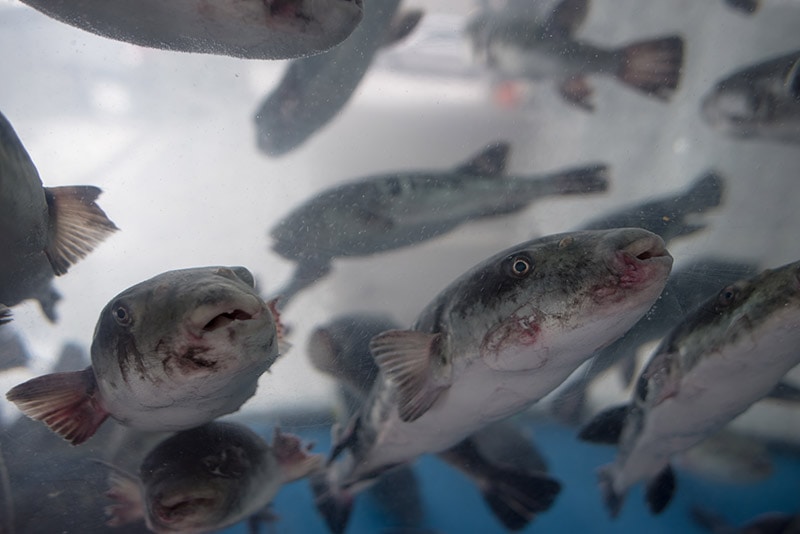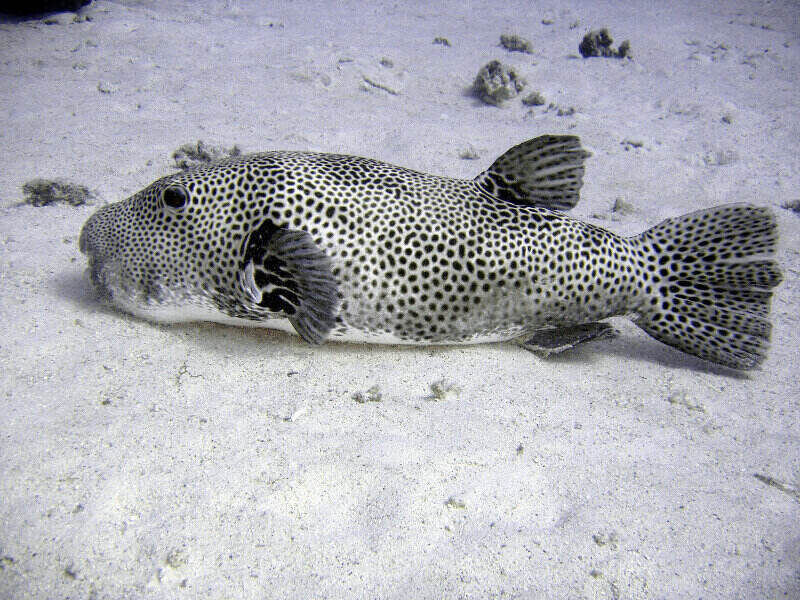The Panther Puffer is a handsome and attractive fellow. They do have teeth, and will chow down on lots of things. So, as they get bigger, keep that in mind when you are putting your fingers in the aquarium!
They can grow up to 14″ (35 cm), so you will need a large aquarium if you plan on keeping this one. Like all puffers, the Panther Puffer is very hardy and easy to maintain.
- For more information on keeping this fish see: Guide to a Happy, Healthy Marine Aquarium
Panther Puffer (Takifugu pardalis)
This video shows someone filming the Panther Puffer in the wild. As you can see they have the dull orange (sometimes yellow) fins, orangish red eyes, dull back with black spots on the upper half fo the body and white below (can’t tell in this video). These are cold water puffers, inhabiting waters that are 50˚F to 64.4˚F (10 to 18˚C). They need a 180 gallon tank with a chiller and should not be housed with their own kind or any other puffer.
Scientific Classification
| Kingdom: | Animalia |
| Phylum: | Chordata |
| Class: | Actinopterygii |
| Order: | Tetraodontiformes |
| Family: | Tetraodontidae |
| Genus: | Takifugu |
| Species: | pardalis |
Maintenance difficulty:
Although the Panther Puffer is easy to feed and generally hardy, they require special care and a special diet to stay healthy.
Maintenance:
Puffers have strong teeth that grow throughout their lives. They need to be offered hard shelled live food often to keep their teeth worn down. For a better explanation and links to the practice of puffer dentistry (if needed) please read here. Because they eat a meaty diet and are often messy eaters, puffers will produce a large bio load on the biological filter of your aquarium requiring frequent water changes and good maintenance practices.
Habitat: Natural geographic location:
The panther puffer is found in the Northwest Pacific from Hakodate, Japan to the East China and Yellow seas.
Foods:
Puffers are primarily predatory fish in the wild, though they do graze on algae as well. Acceptable foods include shellfish, crustaceans and hard shelled foods such as snails. A large variety of all kinds of live and frozen meaty foods are best. It is best to feed small amounts several times a day. Some of the suggested frozen foods include prawn, crabs/crabs legs, bloodworms (live or frozen), blackworms (live or frozen), silversides, and mussels. Be sure to wash these foods thoroughly before feeding. Live foods can include snails, crabs, crayfish, shrimp (these are good for keeping their teeth trimmed), and earthworms. Live fish will also be eaten but it is thought it may cause problems such as ‘fatty” liver and so should be fed sparingly or not at all.. Puffers are not picky eaters and will quickly become adapted to a variety of prepared aquarium foods and an occasional algae wafer. Flake food is not recommended. Even though they may eat it, puffers will not thrive on it.

Social Behaviors:
I have no information on this yet.
Sex: Sexual differences:
Light: Recommended light levels:
Temperature:
No special requirements. Normal temperatures for marine fish is between 74 and 79 degrees Fahrenheit.
Length/Diameter of fish:
Panther Puffer adults can grow to 35 cm (14 inches).
Minimum Tank Length/Size:
A minimum 75 gallon aquarium is recommended.
Water Movement: Weak, Moderate, Strong
Water Region: Top, Middle, Bottom
Availability:
This fish is available from time to time.
- Beginner Fish – Saltwater fish for beginners
- Community Fish – Peaceful Saltwater fish
- Hardy Fish – Hardy Saltwater fish
Featured Image Credit: PxFuel
